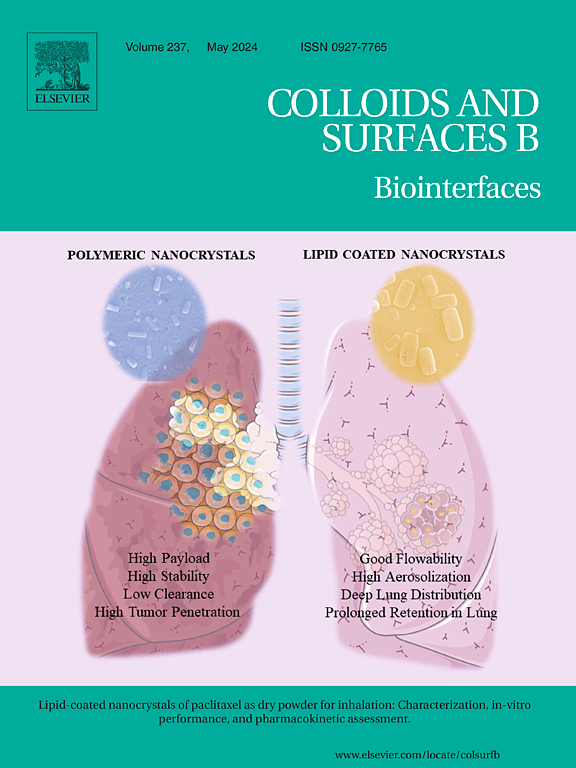Facultative probiotics enable improved tumor distribution and deep penetration of photosensitizer for enhanced photodynamic therapy
IF 5.4
2区 医学
Q1 BIOPHYSICS
引用次数: 0
Abstract
Photodynamic therapy (PDT) is an emerging cancer therapy known for its non-invasive approach and minimal side effects. However, the clinical effectiveness of PDT is limited by the poor distribution and penetration of photosensitizers (PS) in tumors. In this research, we developed a novel delivery system for PS, termed EWC, using the facultative probiotic Escherichia coli Nissle 1917 (EcN) as a carrier. Chlorin e6 (Ce6) was electrostatically adsorbed onto the surface of EcN with the assistance of water-soluble chitosan (WCS). EWC demonstrated effective photodynamic activity and was readily internalized by human lung cancer cells (A549). In vitro assays confirmed its low toxicity to mammalian cells and potent photodynamic cytotoxicity against A549 cells. Additionally, EWC penetrated tumor spheroids and inhibited their growth, as shown by 3D fluorescence imaging. In vivo tests revealed that EWC enhanced the distribution and accumulation of Ce6 at the tumor site, effectively inhibiting tumor growth under light stimulation. Moreover, EWC exhibited excellent biocompatibility in mice. This facultative probiotics-based delivery system significantly improves the efficiency of PDT, offering a promising approach for low-toxicity and high-efficiency tumor therapy.
面性益生菌可改善光敏剂的肿瘤分布和深层渗透,从而增强光动力疗法。
光动力疗法(PDT)是一种新兴的癌症疗法,以其无创伤、副作用小而著称。然而,由于光敏剂(PS)在肿瘤中的分布和渗透性较差,光动力疗法的临床效果受到了限制。在这项研究中,我们开发了一种新型的光敏剂递送系统,称为 EWC,它使用面性益生菌大肠杆菌 Nissle 1917(EcN)作为载体。在水溶性壳聚糖(WCS)的帮助下,氯素e6(Ce6)被静电吸附在EcN表面。EWC 表现出有效的光动力活性,并很容易被人类肺癌细胞(A549)内化。体外实验证实,EWC 对哺乳动物细胞的毒性很低,对 A549 细胞具有很强的光动力细胞毒性。此外,三维荧光成像显示,EWC 能穿透肿瘤球体并抑制其生长。体内测试表明,EWC 能增强 Ce6 在肿瘤部位的分布和积累,在光刺激下有效抑制肿瘤生长。此外,EWC 在小鼠体内表现出良好的生物相容性。这种基于面性益生菌的递送系统显著提高了光动力疗法的效率,为低毒高效的肿瘤治疗提供了一种前景广阔的方法。
本文章由计算机程序翻译,如有差异,请以英文原文为准。
求助全文
约1分钟内获得全文
求助全文
来源期刊

Colloids and Surfaces B: Biointerfaces
生物-材料科学:生物材料
CiteScore
11.10
自引率
3.40%
发文量
730
审稿时长
42 days
期刊介绍:
Colloids and Surfaces B: Biointerfaces is an international journal devoted to fundamental and applied research on colloid and interfacial phenomena in relation to systems of biological origin, having particular relevance to the medical, pharmaceutical, biotechnological, food and cosmetic fields.
Submissions that: (1) deal solely with biological phenomena and do not describe the physico-chemical or colloid-chemical background and/or mechanism of the phenomena, and (2) deal solely with colloid/interfacial phenomena and do not have appropriate biological content or relevance, are outside the scope of the journal and will not be considered for publication.
The journal publishes regular research papers, reviews, short communications and invited perspective articles, called BioInterface Perspectives. The BioInterface Perspective provide researchers the opportunity to review their own work, as well as provide insight into the work of others that inspired and influenced the author. Regular articles should have a maximum total length of 6,000 words. In addition, a (combined) maximum of 8 normal-sized figures and/or tables is allowed (so for instance 3 tables and 5 figures). For multiple-panel figures each set of two panels equates to one figure. Short communications should not exceed half of the above. It is required to give on the article cover page a short statistical summary of the article listing the total number of words and tables/figures.
 求助内容:
求助内容: 应助结果提醒方式:
应助结果提醒方式:


